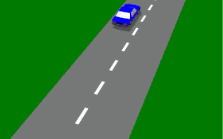A. Put your hazard warning lights on and perform the manoeuvre as quickly as possible to minimise danger
 When reversing, you should:
When reversing, you should:
A. Put your hazard warning lights on and perform the manoeuvre as quickly as possible to minimise danger
B. Unbuckle your seat belt so you can reverse as quickly as possible
C. Sound your horn to warn other drivers
D. Take care and never reverse for a greater distance and time than is necessary
Always check your mirrors and over your shoulder before reversing. If you can’t see behind your vehicle, walk around and check there are no obstructions – too many toddlers are killed and injured in driveway accidents each year due to vehicles reversing into them.
It's more difficult to control your vehicle when reversing than driving forwards, so you should never reverse for any more distance than is necessary.
There are three ways of reversing.
This may not work for a heavy vehicle as there are no quarterlights or rear window. Turn your head over your left shoulder. You can use your left arm to brace behind the passenger seat if you need to, but bear in mind this reduces your control of the wheel. You can unbuckle your seat belt only for reversing if you can't see well enough.
Look into the distance through the rear window and you will be able to judge where you are heading. Bear in mind that for very narrow areas that this method might see you hit something with your wing mirror and therefore you should learn how to reverse using your wing mirrors, too.
Using your wing mirrors is more and more important because modern vehicles have smaller rear windows due to the rear pillars having a thicker construction to make them safer. This technique also is good if you have a stiff neck. If you are driving a heavy vehicle without a rear window, this will be your only technique unless you have a guide (see below).
Adjust your mirrors so that you can just see the side of your vehicle. You might want to angle them down a little for reversing if it's important that you see where your tyres are (this is useful when you are on, say, a slightly raised concrete driveway and you don't want your tyre to fall over the edge which could beach your vehicle on the concrete).
Take it slowly at first. Reversing using your mirrors is more complicated than reversing while looking backwards through the rear window. If you see obstacles getting close in your left mirror, turn the steering wheel slightly clockwise. Bear in mind that this will then direct the front of your vehicle towards the left edge (hence why only turning it slightly clockwise). If you see an obstacle in your right mirror then you will turn the wheel anti-clockwise.
As you are reversing you will need to keep checking the mirrors on both sides of the vehicle. Your mirrors won't cover your blind spots, so be careful.
Remember that you can always stop and get out to have a look if you're not sure. Traps for unwary drivers include raised concrete driveways where it's easy to drop a wheel off the edge and beach the car, roads where the gradient falls away, making it difficult to see out of the back window, and vegetation that constantly gives false readings on reversing sensors.
If you have a reversing camera and sensors, use them. There's more information about reversing cameras and sensors here. But you should never rely just on the reversing camera as they distort the perception of distance and often don't cover enough angle.
A spotter or guide is someone that can go around the back of your vehicle and help guide you. A guide should not be directing you from the front of the vehicle unless they are directing you into a parking space or onto a trailer whereby they can't stand behind you.